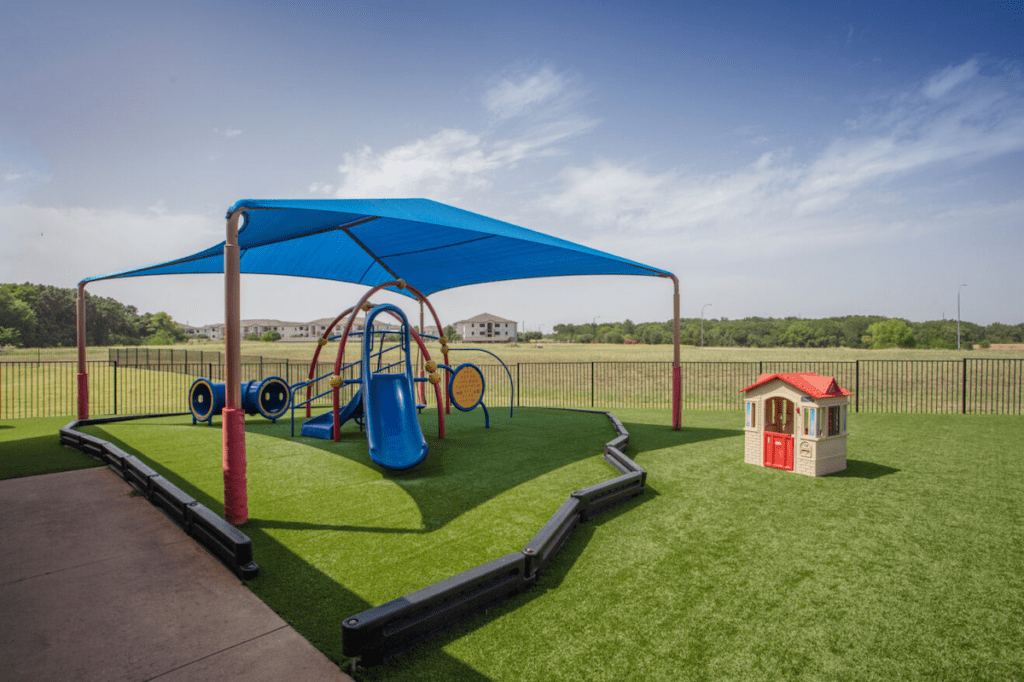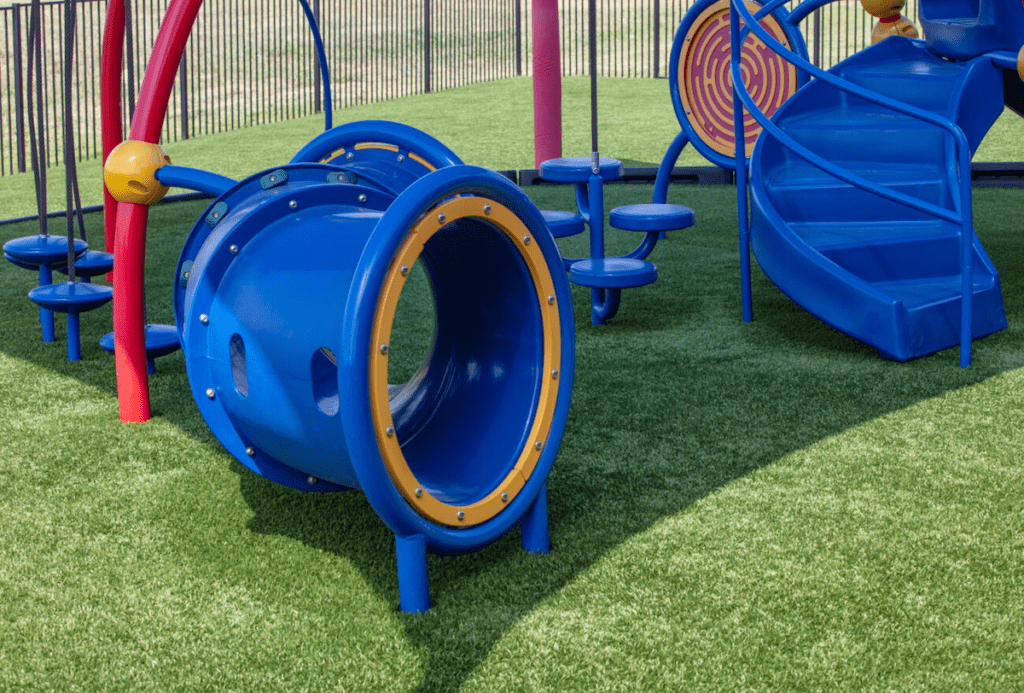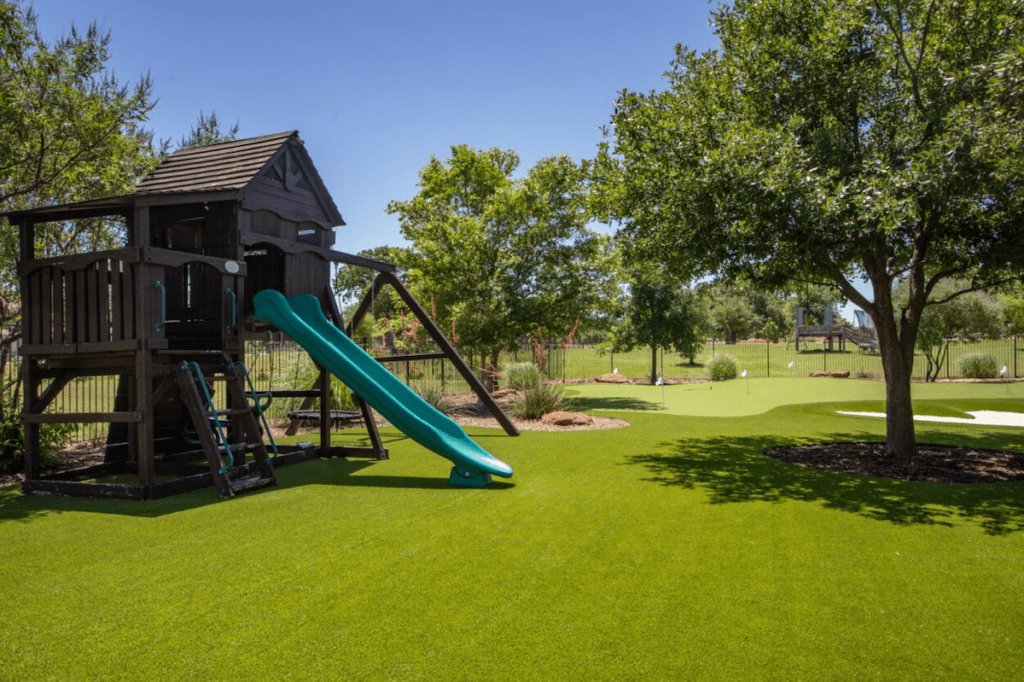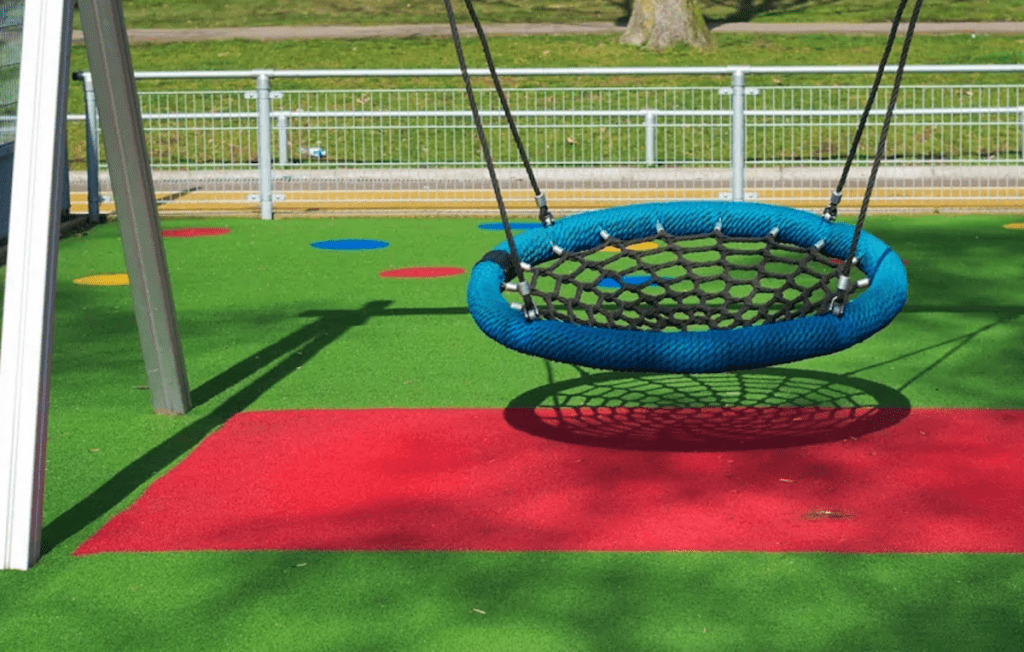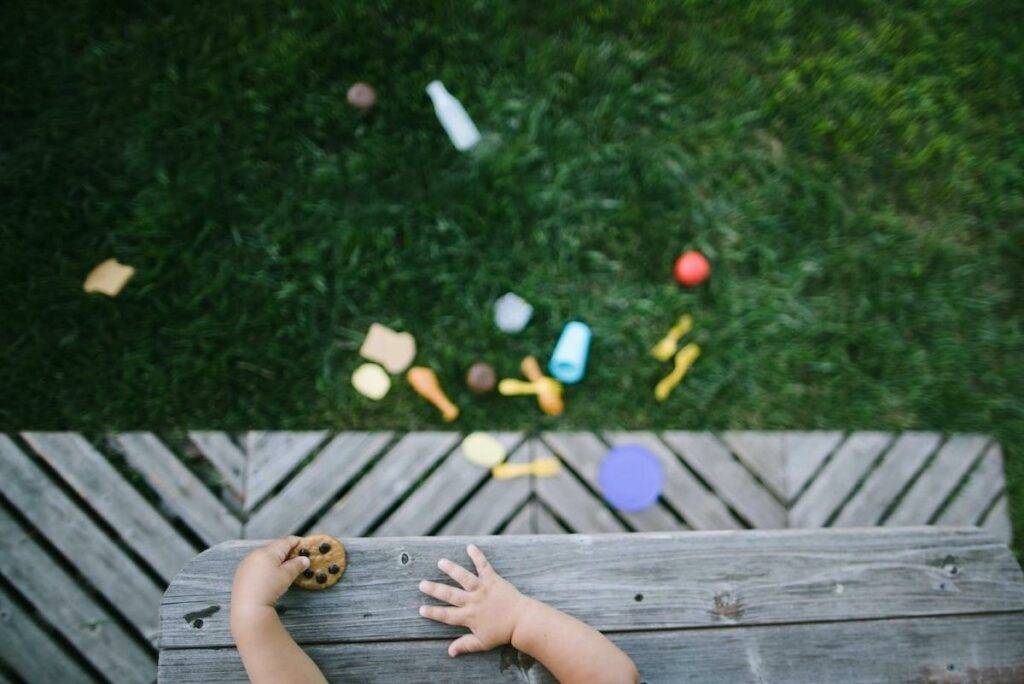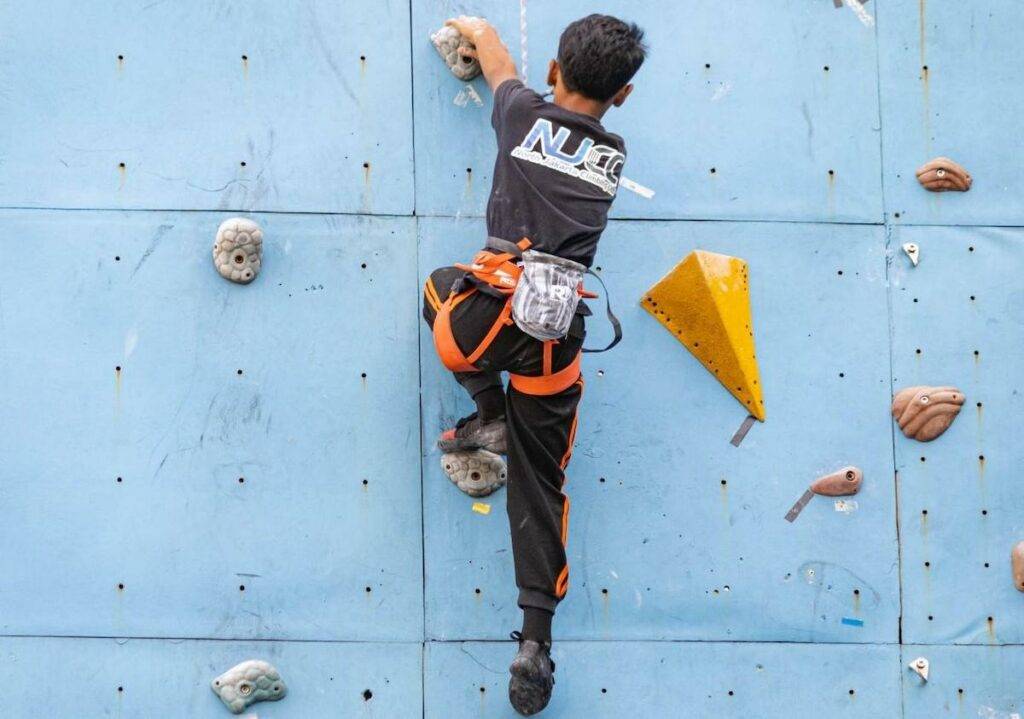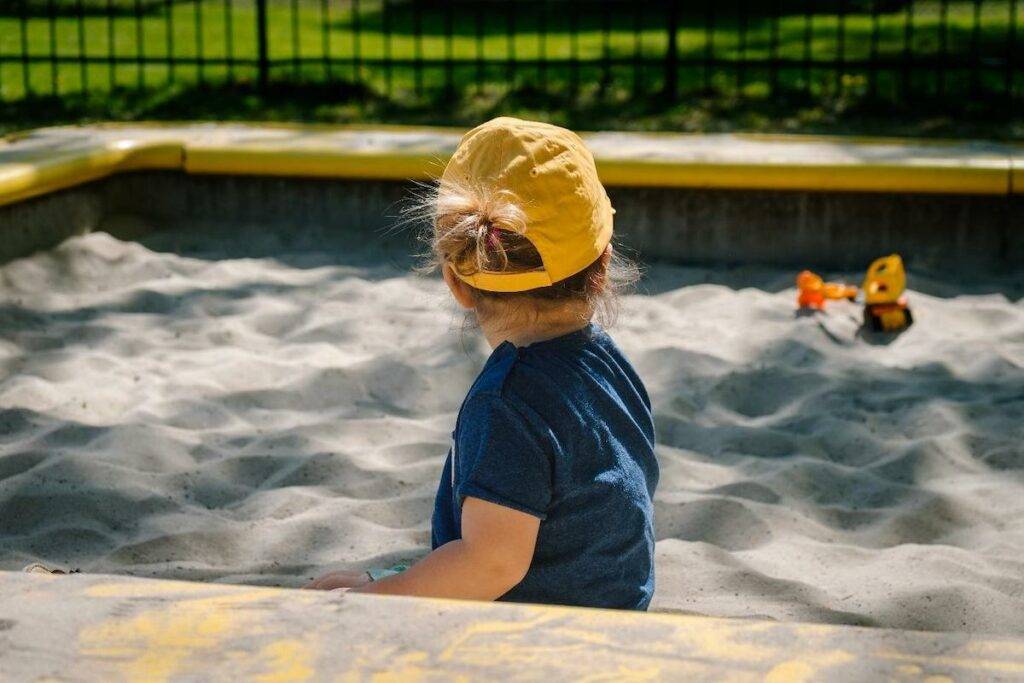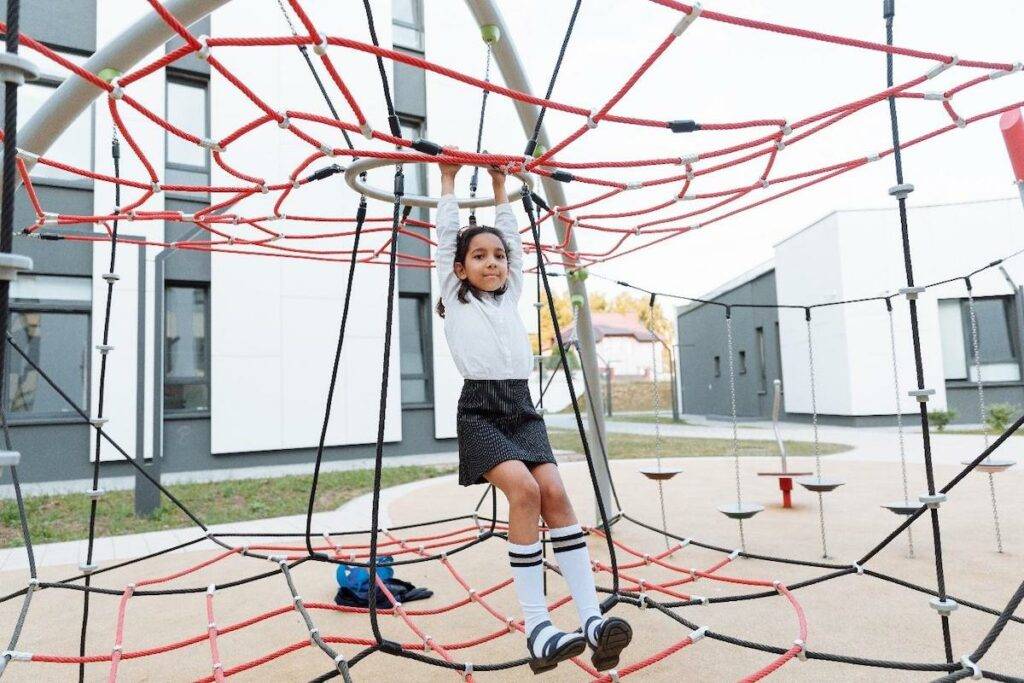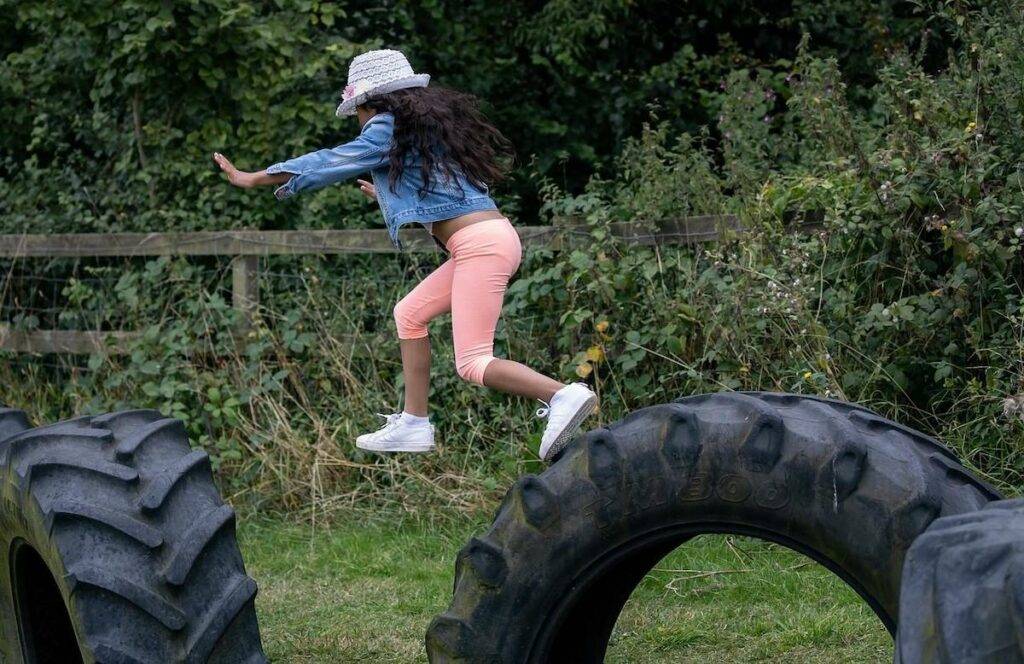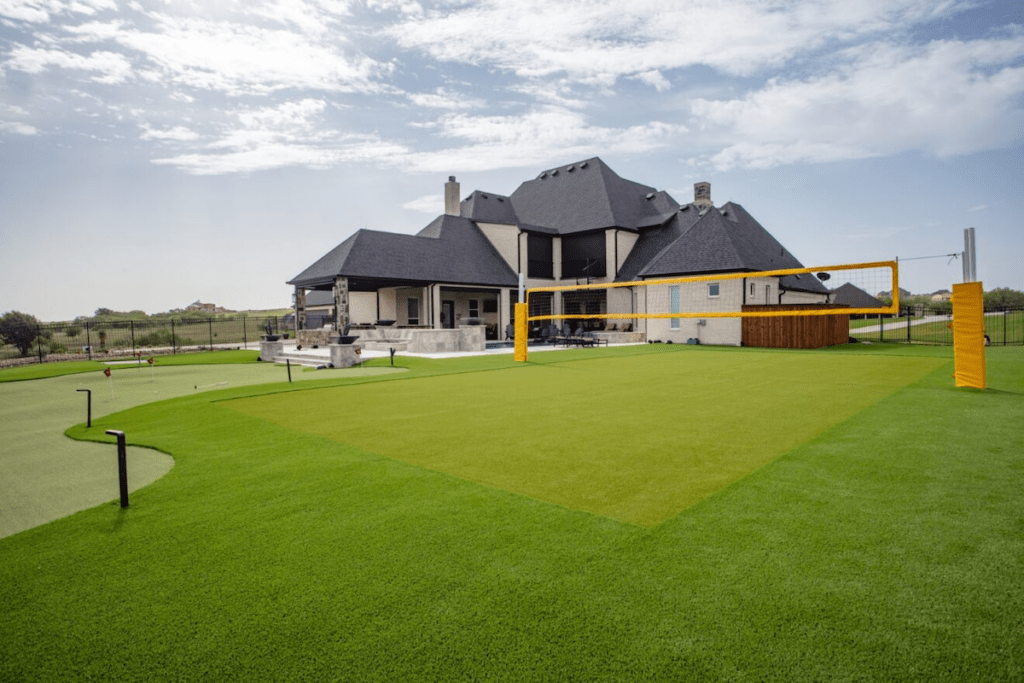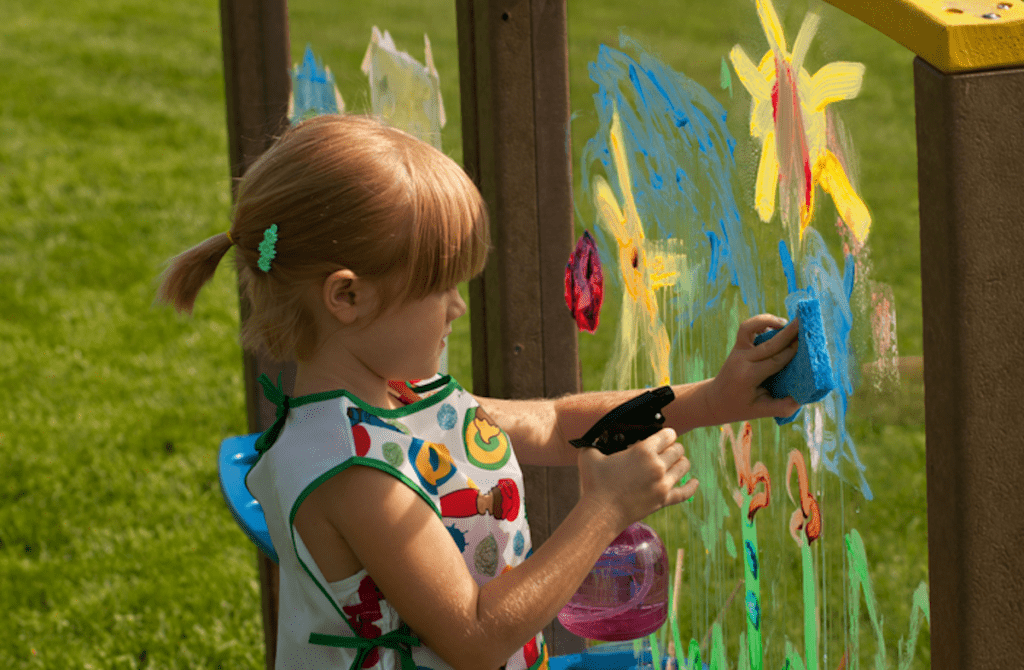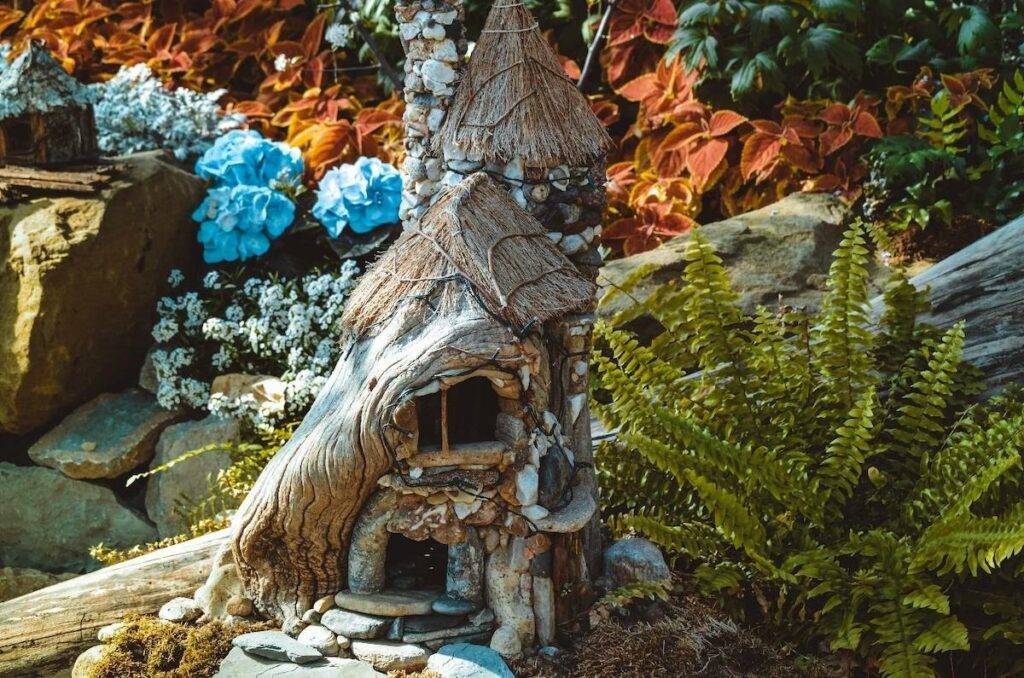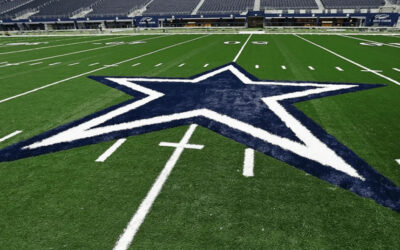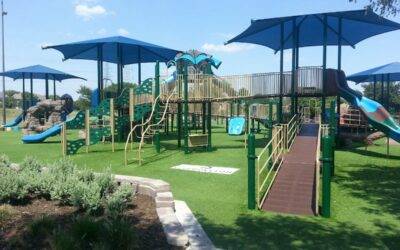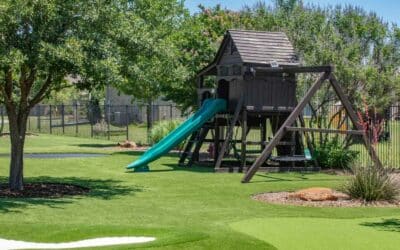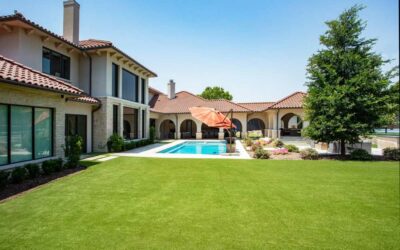Children are five times more likely to be a healthy weight if there is a park or playground within a half mile, according to the National Park and Recreation Association.
So, what better use for a backyard than turning it into a playground that keeps your children healthy, safe, entertained and out of trouble?
Many families in the Dallas-Fort Worth area have plenty of space available for a backyard play area but occupy it with a grass lawn that guzzles water and needs constant attention.
A few creative backyard playground ideas can help transform the space into a fun area that delights your children and looks great all year round with next to no maintenance and no water.
Even if you’re pushed for space, there are plenty of small backyard playground ideas that can help you make the most of it.
We’ve installed many artificial grass play areas in the Dallas-Fort Worth area over the past decade. Let’s go through what you need to know before designing your play area and run down the best backyard playground ideas currently in use by DFW homeowners:
Why build a backyard playground?
Backyard playgrounds come in all shapes and sizes — from elaborate areas with towers, swings, climbing frames and playhouses to smaller areas with little more than a slide or a few containers.
But almost all play areas share the following benefits for homeowners:
- Fun! Keeping children entertained and out of mischief is a constant challenge. A backyard play area means that fun is “on tap” right on your doorstep.
- Convenience: there’s no need to rev up the car engine so often and take the kids to the local park or playground if you can keep them entertained in your backyard.
- Safe, active and healthy play: the more control you have over your children’s play, the safer they will be. Backyard play areas keep you in control and promote safe and active play that expends pent-up energy and promotes healthy exercise.
- Stimulates creativity: interesting and challenging play ideas promote creativity in children and help stimulate the imagination, build confidence and raise self-esteem.
- Cost-effective: backyard playgrounds needn’t be expensive and can end up saving time and money spent on transport fees. Artificial grass for playgrounds requires almost no maintenance, which adds to the cost savings compared to real grass.
- May boost home value: with backyard playgrounds often seen as a niche landscaping feature, the extra curb appeal and impact on the value of your home can make a backyard playground an investment if you later want to sell your property.
- Customized designs: the best backyard playground ideas specifically suit the space available in your yard. Size, shape, features and materials can all be customized to fit the restrictions of your plot.
Artificial grass playgrounds vs. real grass
More homeowners in the Dallas-Fort Worth area and across the U.S. have warmed to the undeniable benefits of artificial grass in the past two decades.
As well as playgrounds, it’s been used for replacement lawns, dog runs, backyard putting greens, swimming pool areas and more.
The advantages of artificial grass have multiplied as the quality has improved and prices have come down. It’s now possible to get affordable, high-quality, low-maintenance artificial grass that closely resembles the appearance and feel of natural grass — making it perfect for backyard playgrounds.
The best artificial grass for playgrounds looks pristine without any maintenance or watering. Synthetic turf resists strong sun and heavy rain as well as scampering feet and rolling bodies and concerns about muddy feet after rain will disappear.
Artificial grass also lasts. Even with the rough and tumble associated with kids’ playgrounds, you can expect at least 10-12 years of active play on professionally installed synthetic grass play areas.
Artificial grass can be used either as the main surface for your play area or as edging for another surface such as crumb rubber, pea gravel, etc. These surfaces are easy to maintain.
What to consider before designing your playground
For a backyard playground that precisely matches what you need, you should plan carefully. The main factors to consider are as follows:
- Safety: this is a priority for most parents. The safety statistics for kids’ playgrounds are alarming (more than 200,000 children go to U.S. hospital emergency departments with injuries associated with playground equipment). All choices made for backyard playgrounds should, therefore, consider this factor, first and foremost.
- The age of your children: it’s obvious that five-year-olds have different play preferences and capabilities to ten-year-olds but it’s also obvious that kids grow quickly. They may also invite their friends (of different ages) to play there. Age is, therefore, a basic consideration for you.
Creativity and stimulation: how can you best stimulate your children’s imagination and creativity? Play is important for building self-confidence and self-esteem in children and this can influence how you design your playground.
- Number of children and frequency of use: if many children are going to use the play area daily, a more robust design is needed to withstand the extra traffic. How do you choose the most durable equipment and ground materials (natural grass is likely to die and develop bald patches under heavy foot traffic)?
- Available space: how much space you have to work with will directly impact your playground design. Larger backyards allow more flexibility with design and more scope for creativity — though plenty of small backyard playground ideas can create fun spaces too.
- Best backyard location: for smaller properties, there may be little choice. With larger backyards, the playground may be located in the most shaded area (especially during peak exposure hours) and away from windows if balls are likely to be thrown.
- Relaxation requirements: when kids have finished playing and want to take a breather or simply cool down (or parents need to supervise their children), should you place some shaded seating like beanbags, loungers or even a teepee around the play area?
- Other landscaping requirements: do you need other areas of your yard landscaped at the same time as installing your playground? It may be more economical to arrange retaining walls or rock features or other parts of your yard at the same time, especially if you’re laying artificial grass.
How playgrounds are built for safety
Nearly 80 percent of playground injuries are caused by falls. This means that the ground surface of a backyard playground must be composed of the right materials.
Not only should materials be non-abrasive, so that they don’t leave scrapes or scratches (like with asphalt) but they also need to absorb shock. Artificial grass for playgrounds must be installed on top of a layer of shock-absorbent padding that prevents fall injuries.
As well as carefully preparing the ground surfaces for backyard playgrounds, parents should prevent the following potential hazards:
- Overcrowded play areas: make sure that there is at least six feet in all directions between playground equipment (nine feet for structures over 30 inches high). Swing set areas should be twice the height of the suspending bar, front and back.
- Sharp hazards: there should be no protruding bolt ends, “S” hooks, or other sharp points or edges on playground equipment.
- Unprotected heights: platforms and elevated areas over 30 inches high should have guardrails or barriers. Openings between rails, bars, rungs or ropes should be less than 3.5 inches or more than nine inches to avoid head entrapment hazards.
- Tripping hazards: avoid exposed concrete footings, tree stumps and rocks, etc.
9 great backyard playground ideas for large yards
Large yards provide great scope to install either DIY/homemade playground ideas or professionally designed play areas.
Here are a few of the top backyard playground ideas for larger yards:
- A full-feature play set
A full-feature playset is suitable for most children beyond toddler age and generally includes a tower, slides, swings and climbing equipment. Smaller children will need supervision, of course.
Additional features may include a playhouse, sandboxes, hammocks, picnic tables and more. The more space you have, the more features you can include.
A large playset in the backyard can mean far fewer trips to the local park playground as you have many of the attractions right there in front of you.
- An elaborate playhouse
A stand-alone playhouse is a safe and fun backyard playground idea for young children from toddler age upwards (provided adequate protections are in place).
Inside the playhouse could be a kitchen that allows children to run wild with their cookery and tea party ideas, boosting creativity and inspiring the imagination.
- Climbing wall
For older children, a climbing wall is a challenging, fun and healthy way to spend time in the backyard.
Climbing builds strength and coordination and, provided it’s installed with the correct safety features and younger children are kept away, it’s a popular addition to a backyard play area.
A cheaper alternative to a rock wall is a cargo net, which can be used as an approach to a treehouse as a creative alternative to steps.
- Water play area
Water can be scarce in these parts of Texas but moving to an artificial grass lawn and play area is a great way to conserve water.
At the same time, the weather here means we need to use water to cool down — and a little water used for play purposes can also go a long way.
Toddlers can play safely with water with a simple water table that allows paddling and splashing about. Great fun! The beauty of combining a little water play with artificial grass (rather than real grass) is that you don’t need to worry about mud and dirt being traipsed back through the house.
A more permanent splash pad with jets, sprays and interactive features is another great backyard playground idea for younger kids if space allows. For older kids, consider water guns and inflatable pools.
- A sandbox/digging area
Digging in and shoveling sand is another activity that can bring hours of fun for young children. By incorporating a sandbox in your backyard play area, you’ll ensure that your child digs safely and hygienically in a designated area rather than among your prize flowerbeds.
This helps to develop motor skills and strengthens muscles, as well as firing the imagination and the senses.
Sandboxes are more practical for larger yards than smaller ones, where floor space is at a premium.
- A trampoline
What kid doesn’t love bouncing up and down on a trampoline? It’s a fun, active way to expend energy and get exercise and is suitable for boys and girls alike.
The following example is built permanently into an artificial grass play area (an inground trampoline) in the Dallas-Fort Worth area:
Alternatively, a portable, fold-away trampoline can be brought out as and when required.
- A jungle gym
A jungle gym can be made of ropes, metal pipes or other materials and encourages many activities such as climbing, hanging, swinging, sitting, jumping and more.
This varied piece of play equipment is a great addition to a backyard play area, helping kids to have fun while exercising and strengthening themselves. They can play independently or in groups — jungle gyms are just as enjoyable either way.
Most jungle gyms can accommodate additional accessories and can be made suitable for children of all ages above toddler size.
- Obstacle course
A similar concept to a jungle gym, an obstacle course offers challenging, fun play that both entertains children and promotes health and fitness.
A backyard obstacle course can be whatever you like — a pre-designed course set that you buy or something you assemble as a DIY project. It can be made of items left lying around like old car tires, cones, pool noodles, ropes and so on. Just make sure that whatever you assemble is safe.
- A sports court
Basketball, tennis, volleyball, pickleball, badminton, paddle tennis, futsal, hockey, mini golf, bowling… the ideas for a backyard sports play area are almost endless if you have the space.
Again, encouraging active exercise for your kids is healthy and fun. Team sports can also help your children develop social skills with friends they invite around. Just make sure that you get the ground surface right. Artificial grass is ideal for most sports court purposes. This backyard in the DFW area features not only an artificial grass putting green but a volleyball court too:
6 small backyard playground ideas
Not all homes have almost unlimited space. Townhouses, for example, may have smaller yards that severely limit the space for kids’ play areas.
But just because you have a small backyard doesn’t mean you need to abandon the idea of a kids’ play area…
- A small yard play set
The beauty of play sets is that they come in all sizes and can be custom-designed to suit yards of all sizes.
Standalone swings take up space because they need clearance front and back (at least twice the height of the suspending bar). So, making a slide rather than a swing the centerpiece of your play set can save a lot of space.
With the right design, you might be able to include a small tower, climbing wall and slide surrounded by artificial grass to cushion falls.
- Incorporate existing trees in your play area design
Kids love to hide out in “secret” places. If you have a large tree in your yard, a treehouse is a great small backyard playground idea that utilizes the existing features without taking up extra space.
A treehouse may start with little more than a wooden platform to make the tree easier to climb. Converting the upper area into a secret den can make it even more intriguing for kids, who can spy on Dad tending the flower beds or Mum hanging out the washing.
A large tree also provides plenty of shade from the Texan sun. Why not include a hammock below the tree too? Some homeowners even add a slide or swing to a large branch below the treehouse.
- A wipe-clean artboard
The best place for children to get messy is outside. You can make this easier with a few simple backyard playground ideas.
If you don’t want to set up a mud kitchen, then another way to encourage creative mess that sparks the imagination is with a wipe-clean artboard.
Mounted on an easel or outside table, an artboard encourages children to play around with colored paints. If it’s placed on artificial grass, gravel or sand, any paint spills or stains can easily be cleaned up.
- A sensory bin
Another idea for stimulating the senses and promoting creativity in more confined backyard areas is a “sensory bin”.
Sensory bins are usually large containers filled with sand, toys and items that encourage play. Think of them as mini-sandboxes but you could also use colored gravel or even uncooked rice if you don’t have sand.
You might create a terrain for toy soldiers, cars and diggers, sea creatures or other favorite play items. Sensory bins don’t require much space or many items to spark a child’s imagination.
- A fairy garden
Another small backyard playground idea that takes up very little space and can spark a child’s imagination is a fairy garden or miniature world.
Encourage your children to design dwellings and landscapes for “little people” using existing items around the backyard. Fallen tree trunks or branches, old hosepipes, flowerpots, old gumboots, birdboxes and even the flowerbeds or rock garden are fair game.
Just make sure that the fairy garden is placed in a shaded area of the yard as the kids might be there for hours!
- Outdoor game area
It’s a constant struggle to prevent too much “screen time” with children and to get them outside. If you don’t have room for a sports court in your backyard, how about an area for yard games?
Classic games like Twister, red-light/green-light, Cornhole and Ladder Toss don’t take much space and you might even have some board games available like checkers, chess, and Jenga. Some of these have yard-size versions that make them even more appealing for kids.
FAQs
Turn your backyard into a play paradise
Whether you have vacant space in your backyard or are planning an overhaul of an existing play area, the above backyard playground ideas can help you decide what’s best.
We can help you design a safe and fun play paradise for your kids right there in your yard — regardless of how much space you have to work with.If you’re in the Dallas-Fort Worth area, get a free quote for a backyard play area by calling DFW Turf Solutions. Remember, we provide a limited 15-year warranty on all workmanship and the artificial turf itself is backed by a 15-year manufacturer warranty.

